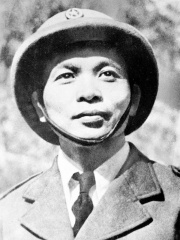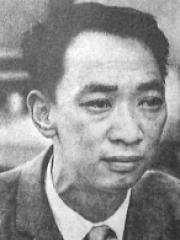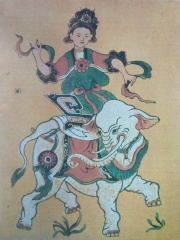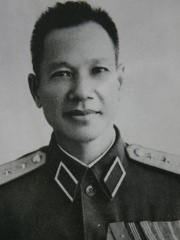



The Most Famous
MILITARY PERSONNELS from Vietnam
This page contains a list of the greatest Vietnamese Military Personnels. The pantheon dataset contains 2,058 Military Personnels, 4 of which were born in Vietnam. This makes Vietnam the birth place of the 54th most number of Military Personnels behind Tunisia, and South Korea.
Top 4
The following people are considered by Pantheon to be the most legendary Vietnamese Military Personnels of all time. This list of famous Vietnamese Military Personnels is sorted by HPI (Historical Popularity Index), a metric that aggregates information on a biography's online popularity.

1. Võ Nguyên Giáp (1911 - 2013)
With an HPI of 75.09, Võ Nguyên Giáp is the most famous Vietnamese Military Personnel. His biography has been translated into 77 different languages on wikipedia.
Võ Nguyên Giáp (chữ Hán: 武元甲, Vietnamese pronunciation: [vɔ̌ˀ ŋʷīən jǎːp]; 25 August 1911 – 4 October 2013) was a Vietnamese general, communist revolutionary and politician. Highly regarded as a military strategist, Giáp led Vietnamese communist military forces to victory in the decades long Indochina wars. Giáp was the military commander of the Việt Minh and the People's Army from 1941 to 1972, minister of defense of the Democratic Republic of Vietnam (North Vietnam) and the Socialist Republic of Vietnam in 1946–1947 and from 1948 to 1980, and deputy prime minister from 1955 to 1991. He was a member of the Politburo of the Communist Party of Vietnam. Born in Quảng Bình province to an affluent peasant family, Giáp began participating in anti-colonial political activity in 1925. Sources conflict as to whether he joined the Indochinese Communist Party in 1930, or not until 1940. Giáp rose to prominence during World War II as the military leader of the Việt Minh resistance against the Japanese occupation, and after the war led anti-colonial forces in the First Indochina War against the French. He won a decisive victory at the 1954 Battle of Dien Bien Phu, which ended the war. In the Vietnam War, Giáp led the PAVN against South Vietnam and the United States. Giáp was commander of the army during the 1968 Tet Offensive and 1972 Easter Offensive, after which he was succeeded by Văn Tiến Dũng, but remained defense minister through the U.S. withdrawal and final victory against South Vietnam in 1975. Giáp oversaw his final campaigns in the successful Vietnamese invasion of Cambodia in 1978 and the 1979 Sino-Vietnamese War. He resigned as defense minister in 1980 and left the Politburo in 1982. Giáp remained on the Central Committee and as deputy prime minister until 1991, and died in 2013 at age 102. Giáp is regarded as a great military leader. During the First Indochina War, he transformed a disorganized band of rebels to a "fine light-infantry army" fielding cryptography, artillery and advanced logistics capable of challenging the larger, modernised French Far East Expeditionary Corps and Vietnamese National Army. Giáp, who in the 1930s had studied law and worked as a history teacher, had never received any military training prior to World War II. A highly effective logistician, he was the principal architect of the Ho Chi Minh trail, the logistical network from North to South Vietnam, through the kingdoms of Laos and Cambodia, which is recognised as one of the 20th century's great feats of military engineering. Giáp is often credited with North Vietnam's military victory over the United States and South Vietnam. Recent scholarship cites other leaders as more prominent, with former subordinates and later rivals Dũng and Hoàng Văn Thái later having a more direct military responsibility. Nevertheless, he was crucial to the transformation of the PAVN into "one of the largest, most formidable" mechanised and combined-arms fighting force capable of defeating the Army of the Republic of Vietnam (ARVN) in conventional warfare.

2. Nguyễn Ngọc Loan (1930 - 1998)
With an HPI of 65.21, Nguyễn Ngọc Loan is the 2nd most famous Vietnamese Military Personnel. His biography has been translated into 22 different languages.
Nguyễn Ngọc Loan (Vietnamese: [ŋʷǐənˀ ŋâwkp lʷāːn]; 11 December 1930 – 14 July 1998) was a South Vietnamese general and chief of the South Vietnamese National Police. Loan gained international attention when he summarily executed a handcuffed prisoner of war named Nguyễn Văn Lém on February 1, 1968, in Saigon, Vietnam during the Tet Offensive. Nguyễn Văn Lém was a Viet Cong (VC) member. South Vietnamese Vice President Nguyễn Cao Kỳ stated that Lém was "a very high ranking" political official, but had not been a member of the Viet Cong military. The event was witnessed and recorded by Võ Sửu, a cameraman for NBC, and Eddie Adams, an Associated Press photographer. The photo and film became two famous images in contemporary American journalism. Despite the determination of the Immigration and Naturalization Service that Loan committed war crimes, owing to which he was liable for deportation back to Vietnam, the then US President, Jimmy Carter, intervened personally to halt the deportation proceedings.

3. Lady Triệu (225 - 248)
With an HPI of 63.31, Lady Triệu is the 3rd most famous Vietnamese Military Personnel. Her biography has been translated into 24 different languages.
Lady Triệu (Vietnamese: Bà Triệu, [ɓàː t͡ɕiə̂ˀu], Chữ Nôm: 婆趙, died 248 AD) or Triệu Ẩu ([t͡ɕiə̂ˀu ʔə̂u], Chữ Hán: 趙嫗) was a female warrior in 3rd century Vietnam who managed, for a time, to resist the rule of the Chinese Eastern Wu dynasty. She is also called Triệu Thị Trinh, although her actual given name is unknown. She is quoted as saying, "I want to ride storms, kill orcas in the open sea, drive out the aggressors, reconquer the country and undo the ties of serfdom, not to bend my back to be the concubine of whatever man." The uprising of Lady Triệu is usually depicted in modern Vietnamese National History as one of many chapters constituting a "long national independence struggle to end foreign domination." She is also known as Lệ Hải Bà Vương (chữ Hán: 麗海婆王, lit. "beautiful sea's lady king").

4. Trần Văn Trà (1919 - 1996)
With an HPI of 55.93, Trần Văn Trà is the 4th most famous Vietnamese Military Personnel. His biography has been translated into 15 different languages.
Nguyễn Chấn, known as Trần Văn Trà (15 September 1919 – 20 April 1996) was a colonel-general in the People's Army of Vietnam. He was Commander of B2 Front during 1963 – 1967, Deputy Commander of Liberation Army of South Vietnam during 1968 – 1972; member of the Central Committee of the Workers' Party of Vietnam from 1960 to 1982 (3rd and 4th terms) and second chairman of Saigon administration after Fall of Saigon.
People
Pantheon has 4 people classified as Vietnamese military personnels born between 225 and 1930. Of these 4, none of them are still alive today. The most famous deceased Vietnamese military personnels include Võ Nguyên Giáp, Nguyễn Ngọc Loan, and Lady Triệu.
Deceased Vietnamese Military Personnels
Go to all RankingsVõ Nguyên Giáp
1911 - 2013
HPI: 75.09
Nguyễn Ngọc Loan
1930 - 1998
HPI: 65.21
Lady Triệu
225 - 248
HPI: 63.31
Trần Văn Trà
1919 - 1996
HPI: 55.93
Overlapping Lives
Which Military Personnels were alive at the same time? This visualization shows the lifespans of the 3 most globally memorable Military Personnels since 1700.

